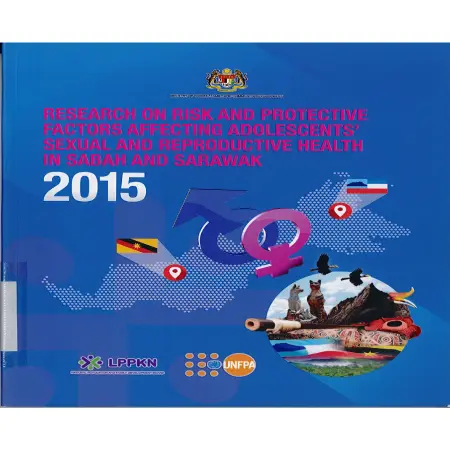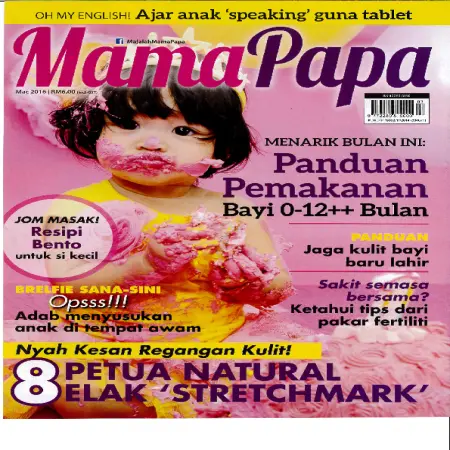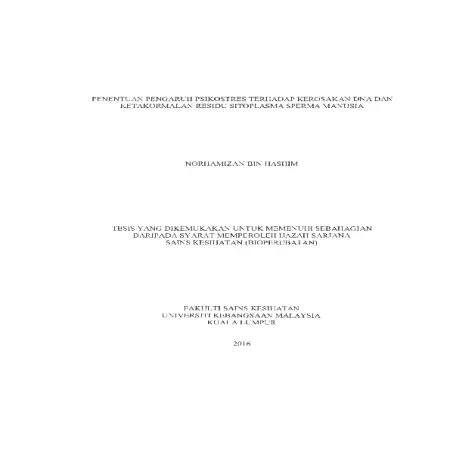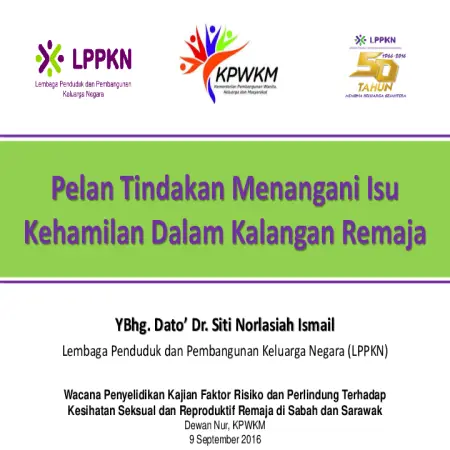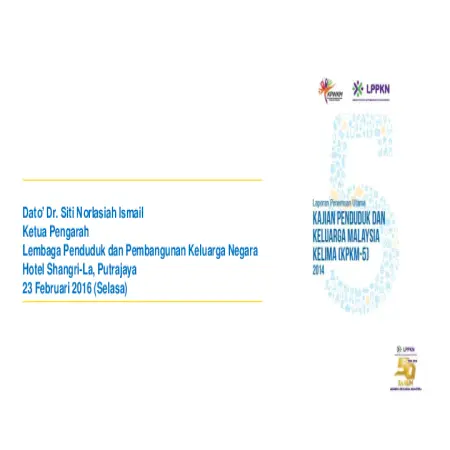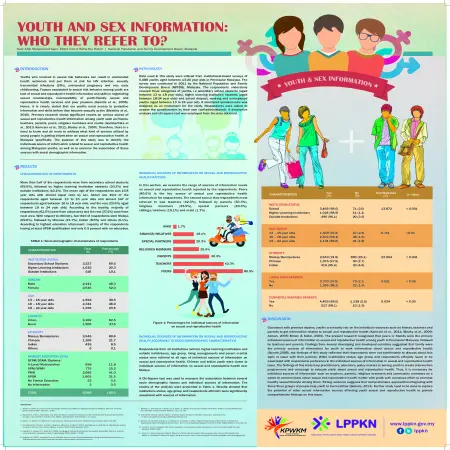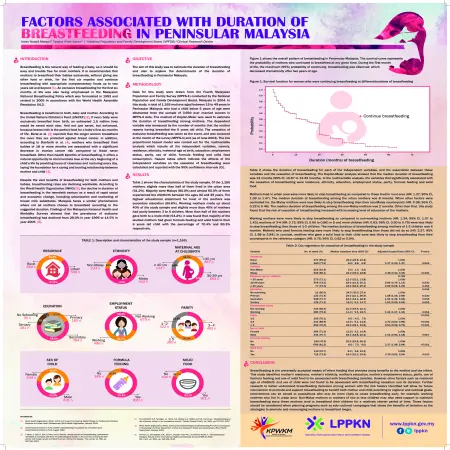TOPICS
Results for Topics : "Health"
|
|
Research on risk and protective factors affecting adolescents' sexual and reproductive health in Sabah & Sarawak 2015
Item Type: Research Report
Editor:
Year: 09/09/2016
Abstract: A quarter of the world population (1.8 billion) consists of people aged 10-24 years (UN DESA, 2009). Adolescents is a phase of life whereby they have opportunities for developing healthy behaviours, which can determine the future pattern of adulth health. However, for most adolescents, this is the phase of self-discovery whereby they undergo biological, psychological, social and economic changes in their life. Curiosity and experimentation are normal among them where certain behaviours would place adolescents at risk of undesired consequences of their activity.
There are various biological, social, educational and psychological risk factors that predispose adolescents to unhealthy and unsafe sexual phenomena such as premarital sex, having multiple sexual partners, unwanted pregnancy, early childbearing and illegal abortion. In terms of biological factors, early menarche, being male men and older age were found to be the significant risk factors. In addition, social factors including unemployment, peer influence (peer/ friends who have had sexual experience) and use of the substance such as alcohol, tend to increase the tendency of unsafe and unhealthy sexual practices (WHO, 2004). Besides, lack of sexual reproductive health information and skills in negotiating sexual relationship, inaccessibility of youth-friendly SRH services are other risk factors that had been identified (Low, 2006).
Although there is limited data on teenage pregnancy in Malaysia, the increasing reports on incidences of abandoned babies indicate that increased premarital sexual intercourse resulted in unwanted pregnancies among unmarried adolescents. From 2005 to March 2014, it was reported that there were 561 cases of baby dumping (RMP, 2014; Mansoor, 2014). the number of reports of abortion indicates that there is an increase in the number of extramarital sex among unmarried adolescents. Many 51 cases of infant abandonment were reported in 2005 to March 2014 (PDRM, 2014; Mansoor, 2014).
In 2012, a study was conducted to identify the risk and protective factors of adolescents in Peninsular Malaysia (NPFDB, 2015). There has been a dearth of studies on adolescents’ SRH in Sabah and Sarawak. Therefore, studies on SRH among this sub-population are warranted. Furthermore, there are differences in terms of demographic characteristics compared to Peninsular Malaysia. Based on these findings, more specific educational and intervention programmes tailored to the needs of the adolescents in Sabah and Sarawak need to be planned and implemented in order to prevent them from engaging in risky sexual behaviours. The objective of this study was to determine the risk and protective factors related to sexual and reproductive health (SRH) of adolescents in Sabah and Sarawak.
|
|
|
|
|
|
Panduan pemakanan bayi
Item Type: Article
Editor:
Year: 00/03/2016
Abstract: The nutrition of children is based on the same principles as nutrition for adults. Everyone no matter little or adult needs the same nutrients such as vitamins, minerals, fats, carbohydrates and proteins. However, infants and children need different amounts according to age. Infant nutrition is important to ensure that complete nutrients are given to infants for optimal mental and physical development.
|
|
|
|
|
|
Kajian bagi mengenalpasti faktor-faktor risiko kanser payudara yang berkaitan dengan gaya hidup dalam kalangan wanita melayu di Kuala Lumpur
Item Type: Thesis
Editor:
Year: 00/02/2016
Abstract: Breast cancer is the most common cancer that has affected women all over the world. The worldwide rates of breast cancer incidence and mortality show a drastic and alarming increase. Until today the cause of the disease has yet to be identified. However, evidences from extensive researches related to breast cancer found that there were several lifestyle factors and some biomedical factors of the women that are scientifically recognized to increase the risk for breast cancer. In Malaysia, recent data obtained from data obtained from the National Population and Family Development Board (NPFDB) shows the incidence rate of breast cancer among Malay women was
found to have increased drastically in the last 8 years. This study aimed to identify risk factors, especially those related to lifestyle that may increase the risk of breast cancer among Malay women in Kuala Lumpur. The study also examined the knowledge of breast cancer among informants. A total of twelve breast cancer survivors were
interviewed in depth to identify and explore aspects of past lifestyle and biomedical background that may likely to increase their risk of getting breast cancer. Results show that some lifestyle and biological risk factors seen likely to increase the risk of getting breast cancer; late age at first birth or has never given birth (nulliparity), has never
breastfed or short period of breastfed, obesity, physical inactivity, high frequency of red meat intake, less intake of vegetables and fruits, psychological stress, family history of breast cancer and radiation treatment to the chest or breast. The study also found that the majority of the informants had poor knowledge regarding breast cancer.
|
|
|
|
|
|
Penentuan pengaruh Psikostres terhadap kerosakan DNA dan ketakormalan residu sitoplasma sperma manusia
Item Type: Thesis
Editor:
Year: 00/00/2016
Abstract: Idiopathic infertility has been correlated with psychostress which can result in abnormality and declining semen quality in men. Nevertheless, direct relationship of semen quality and psychostress is still unclear. Hence, this study was conducted to evaluate the effect of psychostresson semen quality with emphasizing on sperm DNA damage and cytoplasm droplet abnormality. A total of 628 respondents were selected randomly among men aged between 25-45 years old were patient from LPPKN.
|
|
|
|
|
|
Youth and sex information: who they refer to?
Item Type: Scientific Poster
Editor:
Year: 00/07/2015
Abstract: Youths who involved in sexual behaviors can result in unintended health outcomes and put them at risk for HIV infection, sexuality transmitted infections (STIs), unintended pregnancy and very early childbearing. Factors associated to sexual risk behavior among youth are lack of sexual and reproductive health information and skills in negotiating sexual relationships, inaccessibility of youth-friendly sexual and reproductive health services and peer pressure (Kaestle et Al., 2005). Hence, it is clearly stated that our youths need access to protective information and skills before they become sexually active (Bleakley et al., 2010) Previous research shows significant results on various source of sexual and reproductive health information among youth such as friends, teachers, parents, peers, religious members and media (Gombachika et al.,2013; Kamrani et al., 2011; Bleaky et al., 2009) therefore, there is a need to know and do more address what kind of sources utilized by young people in getting information on sexual and reproductive health, in Malaysia specifically. The purpose of this study was to identify the individuals source of information related to sexual and reproductive health among Malaysia youth, as well as to examine the association of these sources with social demographic information.
|
|
|
|
|
|
Factors associated with duration of breastfeeding in Peninsular Malaysia
Item Type: Scientific Poster
Editor:
Year: 00/00/2015
Abstract: Breastfeeding is the natural way of feeding a baby, so it should be easy and trouble free for most mothers. It is recommended that mothers to breastfeed their babies exclusively, without giving any other food or drink, for the first six months and continue breastfeeding with appropriate complementary foods up to two years old and beyond [1]. An exclusive breastfeeding for the first six months of life was also being emphasized in the Malaysian National Breastfeeding Policy which was formulated in 1993 and revised in 2005 in accordance with the World Health Assembly Resolution 54.2. Breastfeeding is beneficial to both, baby and mother. According to the United Nations Children’s Fund (UNICEF) [2], if every baby were exclusively breastfed from birth, an estimated 1.5 million lives would be saved each year. And not just saved, but enhanced, because breast milk is the perfect food for a baby’s first six months of life. Beral et al. [3] reported that the longer women breastfeed the more they are protected against breast cancer. In addition, according to Danforth et al. [4], mothers who breastfeed their babies of 18 or more months are associated with a significant decrease in ovarian cancer risk compared to those never breastfeed. Other than health benefits of breastfeeding, it offers a natural opportunity to communicate love at the very beginning of a child’s life by providing hours of closeness and nurturing every day, laying the foundation for a caring and trusting relationship between mother and child [2]. Despite the vast benefits of breastfeeding for both mothers and babies, breastfeeding rates are declining worldwide. According to the World Health Organization (WHO) [5], the decline in duration of breastfeeding in the twentieth century as a result of rapid social and economic change, including urbanization and marketing of breast milk substitutes. Malaysia faces a similar phenomenon where not all mothers choose to breastfeed according to the suggested duration. Findings of the Malaysian National Health and Morbidity Surveys showed that the prevalence of exclusive breastfeeding had declined from 29.0 % in year 1996 to 14.5 % in year 2006 [6]. Objective: The aim of this study was to estimate the duration of breastfeeding and also to explore the determinants of the duration of breastfeeding in Peninsular Malaysia.
|
|
|
|
|
|
Mammogram Screening Subsidy: Program in Malaysia
Item Type: Conference or Workshop Item
Editor:
Year: 00/00/2015
Abstract: In Malaysia, a woman has a 1:19 life time risk of developing breast cancer in her lifetime. Breast cancer contributes 32.3% of all female cancers. To reduce the incidence of breast cancer, the Government has embarked on the subsidised Mammogram Screening Program. This aims at promoting greater awareness and encouraging women to undergo mammogram screening for early detection of breast cancer. The objective of this subsidy is to promote greater awareness on breast cancer and the importance of breast examination.
|
|
|
|
|
|
Prevalence and risk factors of pregnancy loss in Malaysia
Item Type: Conference or Workshop Item
Editor:
Year: 00/00/2015
Abstract: The objective of this paper is to study the prevalence and risk factors of pregnancy loss in Malaysia. The risk of pregnancy loss is highest among Indian, followed by Malay and Chinese. The risk of pregnancy loss increases with level of education, age at 1st marriage and number of previous non-live births.
|
|
|
|





